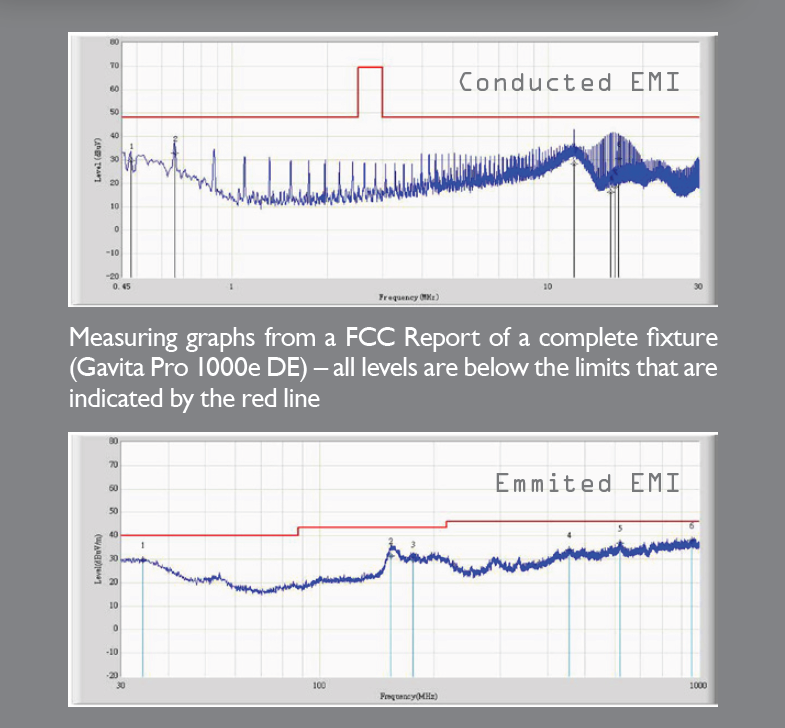Theo Tekstra of Gavita explains a problem innate to most electronics, and familiar to most growers who use HID bulbs: Electromagnetic Interference.

The following is an article produced by a contributing author. Growers Network does not endorse nor evaluate the claims of our contributors, nor do they influence our editorial process. We thank our contributors for their time and effort so we can continue our exclusive Growers Spotlight service.
Disclaimer
This article was originally published on Garden Culture Magazine several years ago, although the information is still valid today. If you would like to read the original article, click here.
The introduction of high frequency electronic remote ballasts into the market has created a new problem: electromagnetic interference (EMI). EMI consists of high frequency signals which are either conducted (such as through your power cord back to the grid), or emitted in the form of radio waves (such as a high frequency remote ballast). EMI can disrupt or degrade the functioning of other electronic devices. In some cases, this may even lead to life threatening situations, for example, if medical systems or emergency communication systems are influenced. So what is EMI, and what can we do to avoid it? What are the rules and regulations?
Standards
First, let’s get the dull stuff out of the way: there are two classes which define how much EMI a device may emit:
- Class A for industrial use
- In industrial environments, the EMI levels are allowed to be a bit higher.
- Class B for residential or medical use.
- Class B, residential use, is more strict than the industrial standard.
Manufacturers of electrical devices need to ensure that they do not emit more than the applicable standard. EMI, however, is a double-edged sword: manufacturers of electronic devices should also make sure that their electrical devices are protected against the influence of EMI from other apparatuses. This, of course, makes things a bit more complicated. Interference you experience may not necessarily come from a device emitting too much, it could well be that the receiving device is not sufficiently protected against EMI.
There are many devices that emit EMI, because they emit radio frequent radiation such as cell phones and radio transmitters. In certain environments usage of these items is restricted, because they could possibly interfere with sensitive systems. Examples include:
- Radio studios and theaters, which could experience interference with audio systems and wireless microphones.
- Hospitals and airplanes, due to possible interference with critical electronic systems.

Radiated and Conducted EMI
There are two different types of EMI:
- Radiated EMI works like a radio wave, and is emitted by the equipment like a radio transmitter. Radio waves are very high frequency: frequencies from 30 kHz and up (long wave). Medium wave, for example, ranges from approximately 500 kHz to 1.7 MHz. This emission can be picked up by devices that are sensitive to these frequencies, without any electrical connection to the device generating the EMI.
- Radiated EMI can, for example, hinder cell phone reception, wireless devices such as intercom systems, monitoring systems and radio amateurs, but it can also induce bad readings on sensitive instruments such as pH and ec meters.
- Conducted EMI travels through the power cord of the device back to the grid, and is distributed over your mains cables. All devices that are plugged into the same mains supply will receive this automatically. The interference does not stop at your house though: a complete block of houses connected to the same supply can be influenced. The frequencies are approximately 9 kHz to 30 MHz.
- Conducted EMI can influence anything that is connected to the same mains supply, and can cause routers to disconnect, computers to fail, loss in data, interference on audio and cable TV systems, etc.
Of the two, the conducted EMI may well be a worse problem than the emitted EMI.
Electronic ballasts and EMI
Electronic ballasts have become popular because they are efficient, lightweight, run relatively cool, provide a stable output regardless of mains voltage fluctuations, and can be controlled. Traditional (low frequency) core-coil ballasts are quite heavy and become very warm. They can be noisy, and some components degrade over time. But the traditional ballasts are cheap, reliable, and cause no interference whatsoever, because they work on the mains frequency: 50/60 Hz!
So why don’t manufacturers make a low frequency electronic ballasts? They do. There are low frequency electronic ballasts as well. Because of the electronic nature of the ballast, they can still cause EMI, and because they are low frequency, they are often big and more expensive. Square wave, low frequency ballasts in particular can be noisy on lamps, resulting in literally vibrating arc tubes. They are also more expensive to produce.
Then there is a huge variety in operating frequency: traditional high frequency ballasts work around 35 kHz, but modern horticultural double ended systems, for example, work at 120 kHz! It’s not only this base frequency that can cause problems. High frequency equipment also generates what we call harmonics, frequencies which are much higher than the base frequency. They easily reach the radio frequent spectrum your other devices are sensitive to. Harmonics are mostly responsible for emitted EMI problems. Sine wave and square wave ballasts both have higher harmonic frequencies. High frequency square wave ballasts in particular generate lots of harmonics and EMI.
Low versus high frequency
Magnetic ballasts output the same frequency as the receive from mains, so 50 Hz in Europe, 60 Hz in the USA. This causes a “flicker” in the light, which actually switches on and off 100/120 times per second. On digital photographs or video cameras you see this as light and dark banding. High frequency electronic ballasts switch so fast that the arc in the arc tube does not extinguish, leading to a higher output and better efficiency.
How to avoid EMI
It is almost impossible to avoid EMI with a high frequency remote ballast. The lamp cord connecting the (shielded) ballast to the reflector is the biggest problem for radiated EMI: it functionally acts as an antenna. The longer the cord, the bigger the antenna. Shielding the lamp cord is not a solution in many cases, as it dampens the ignition pulse and can lead to lamps not starting any more. It also causes losses in output signal, and, in some cases, it actually causes the frequency of the ballast to go up to a much higher frequency, possibly destroying the ballast. This is why in horticulture only complete fixtures are used, with ballast and reflector integrated. The lamp cables are integrated into the metal design, reducing the interference to a minimum.
Conducted EMI is caused by insufficient filtering inside the ballast, or just plain bad design, causing high frequency signals to be delivered back to the grid. This can happen in remote ballasts, as well as complete fixtures.
There are several ways to keep your EMI to a minimum:
- Best option: Use complete fixtures! Ballast and reflector are integrated, so there is no loose lamp cord to emit lots of EMI. They are much easier to wire than remote systems, you just need to bring power to your climate room.
- Make sure you have a good earth connection. The use of a protective earth connection is crucial to avoid EMI in shielded systems. Always use protective earth for safety, but use it specifically for high frequency devices to provide good shielding.
- Keep lamp cords as short as possible, so keep the ballasts as close to the reflector as possible. I am talking about just 15 cm of cable instead of 5 meters or more!
- Keep lamp cords separate from mains cords. If you they cross or run parallel you can get induction of the high frequency output on your mains supply, causing conducted EMI. This feedback signal can even destroy your ballast.
- Never coil your lamp cords, shorten them! A coil can influence the frequency of your ballast, and can amplify radiated EMI.
Harmonics are mostly responsible for emitted EMI problems

EMI measuring rooms ideally do not contain metal objects close to the sources, all tables on which the objects are placed are made of wood.
Keep your family and neighbors happy and safe
EMI can cause all kinds of mayhem in a domestic environment: Internet routers that lose connection, Wi-Fi access points that decrease in performance or lose connection, TV’s and satellite receivers that show interference, remote controls (for example, to open your garage door or arm your alarm system) that do not work anymore, intercom systems that become unusable because of a loud hum, false alarms in wireless systems, amateur radio traffic interference, etc. When the neighbors call the cable guy to search the cause of the problem you are already too late. It is always better to prevent these problems.
So, what should I buy?
If a device carries an FCC or CE sign it should be compliant to the EMI regulations. I say should be, as in reality there are a lot of things wrong with the testing of electronic equipment. For CE certification, for example, the manufacturer may choose to test the equipment himself, and declare that it is compliant to CE. If it turns out that it isn’t compliant he will probably get a slap on the wrist, which in many cases is cheaper than actually being compliant. Manufacturers in cheap labor countries outside the European Community (where the CE certification is required) do not really care much about compliance, and the importer or distributor is held responsible.
For FCC compliance, the device needs to be tested in a lab which is accredited by the FCC. In reality though, there is a huge difference in reports that are obtained from different (accredited) labs from different countries, also depending on how they test. If you test a ballast, for example, with just 15 cm of lamp cord it will give you a much better result than with 4 meters coiled next to the ballast. An FCC approval is no guarantee for absence of EMI.
Be smart when you design a climate room. Think ahead, and choose products from a reliable manufacturer. Realize that all high frequency remote ballasts (even those that are FCC approved) can emit EMI and that in all cases it is better to use complete fixtures. If you use remote ballasts, then place the ballasts as close to the reflectors as possible, and use very short leads. Never cross lamp cords and power cables, and make sure all your systems have perfect ground connections.

10 Best Gift Ideas for Cannabis Connoisseurs and Growing Aficionados (2022)
December 7, 2022Developing and Optimizing a Cannabis Cultivation System
December 14, 2021Dealing with Insomnia: How Can CBD Help?
December 10, 2020Your Guide to Sleep and CBD
December 7, 2020
Do you want to receive the next Grower's Spotlight as soon as it's available? Sign up below!
Resources:
Want to get in touch with Gavita? They can be reached via the following methods:
- Website: https://gavita.com/
- Email: info@gavita.com

Do you have any questions or comments?

About the Author
Theo Tekstra is a horticultural lighting expert, mostly known for his work at Gavita. He is a contributor to many publications, such as Ed Rosenthal's Marijuana Grower's Handbook and Jorge Cervantes' Grow Bible, writes articles and columns for magazines, is a speaker at international events and visiting professor at Dutch horticultural schools. His insights and experience from a breeding, growing as well as a horticultural lighting point of view give him a unique perspective into cannabis cultivation. For many years he led the largest Dutch online cultivation community and he has thousands of posts on international fora and in special interest groups.